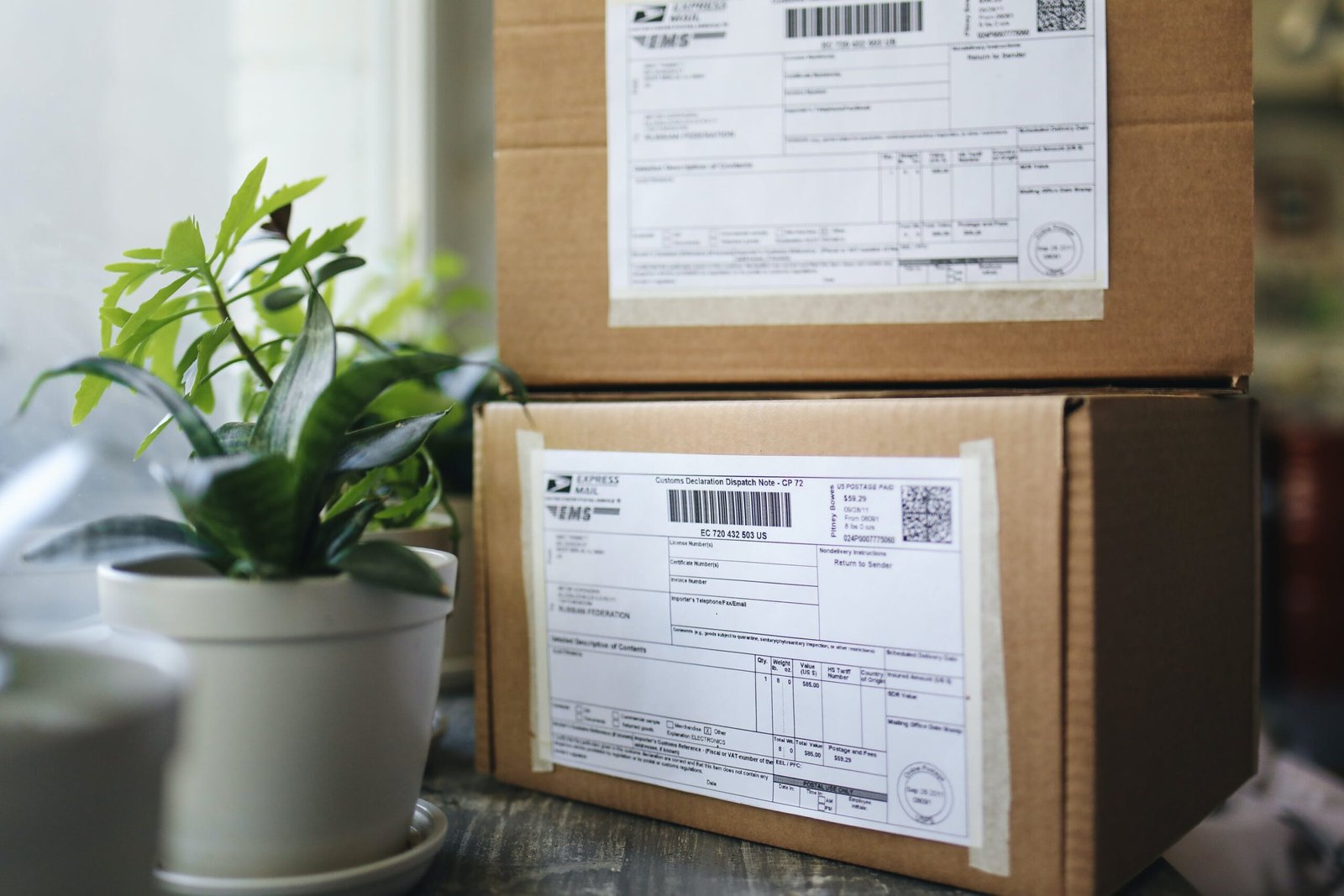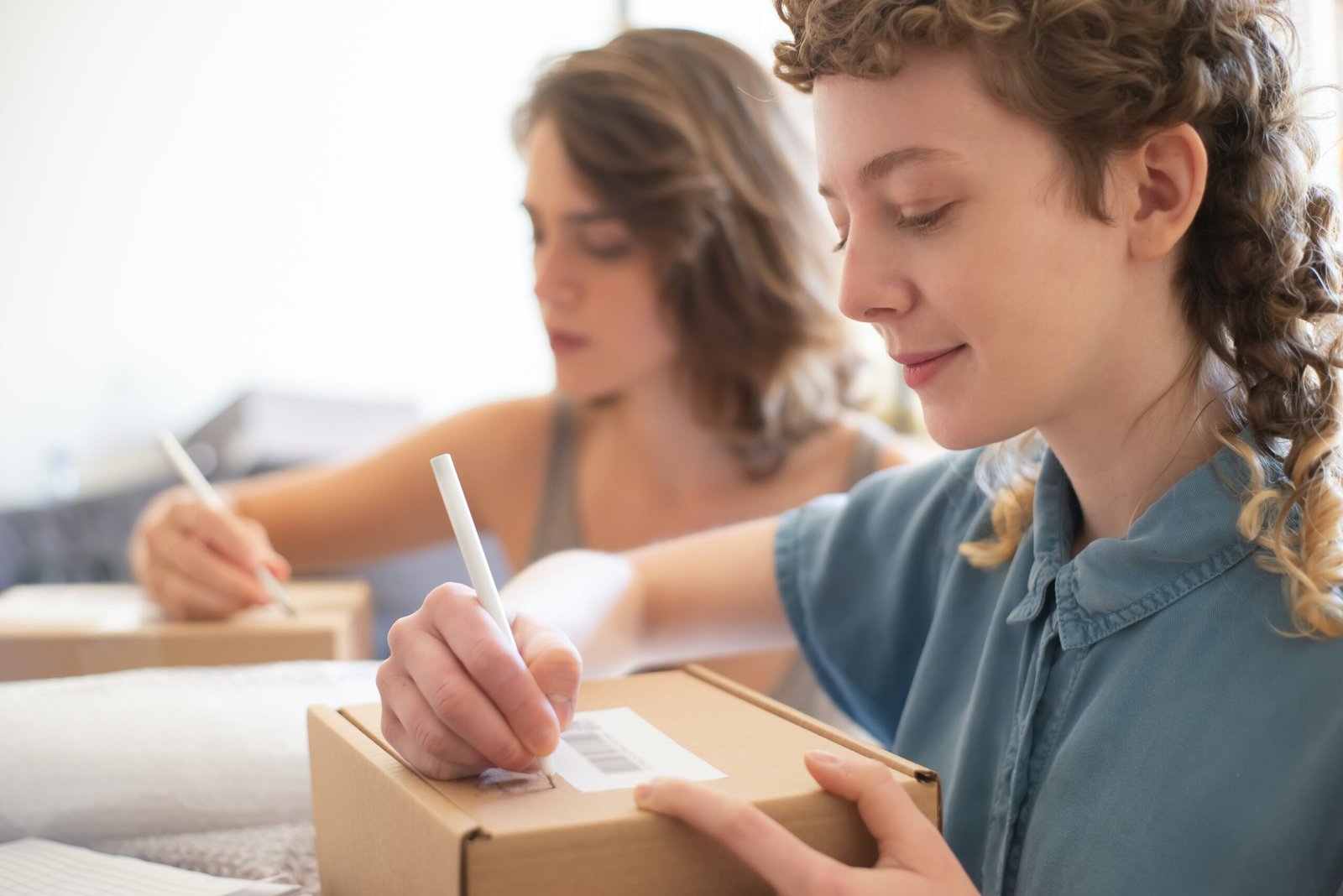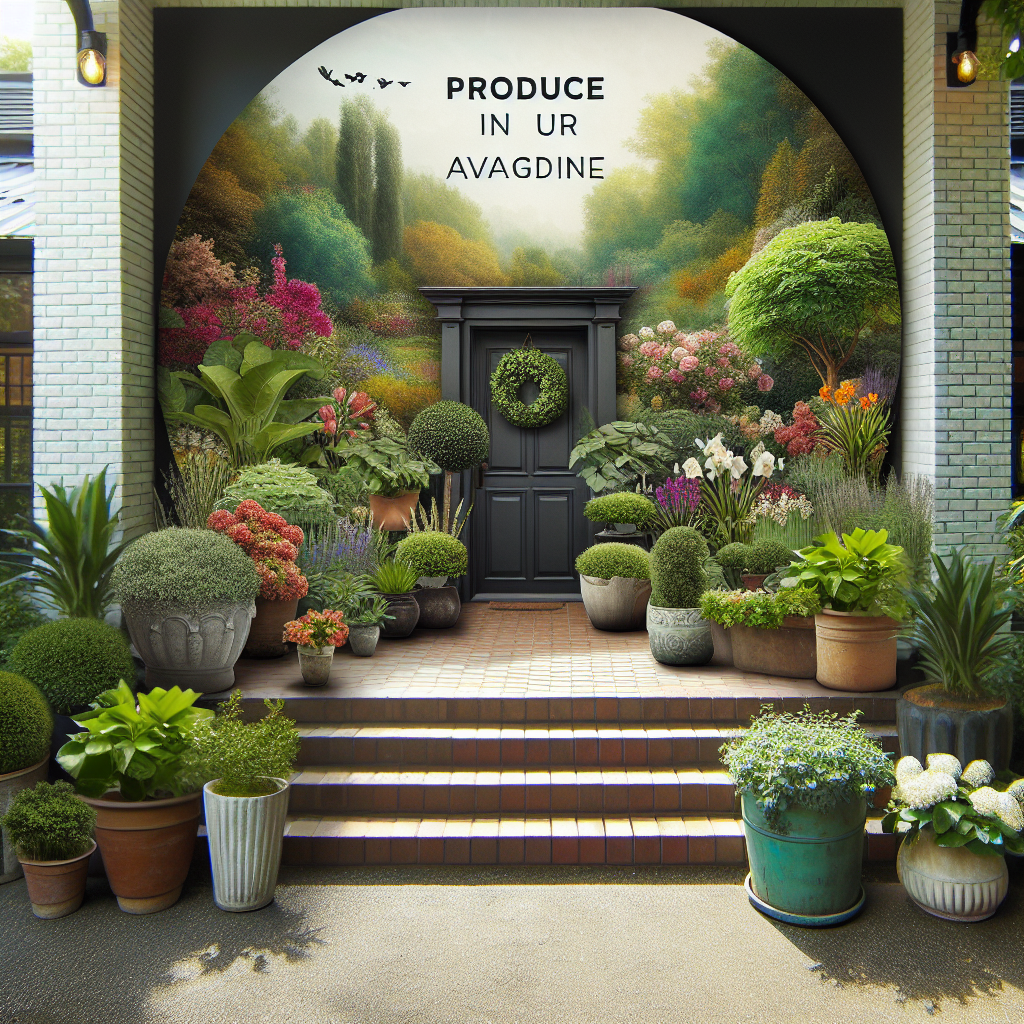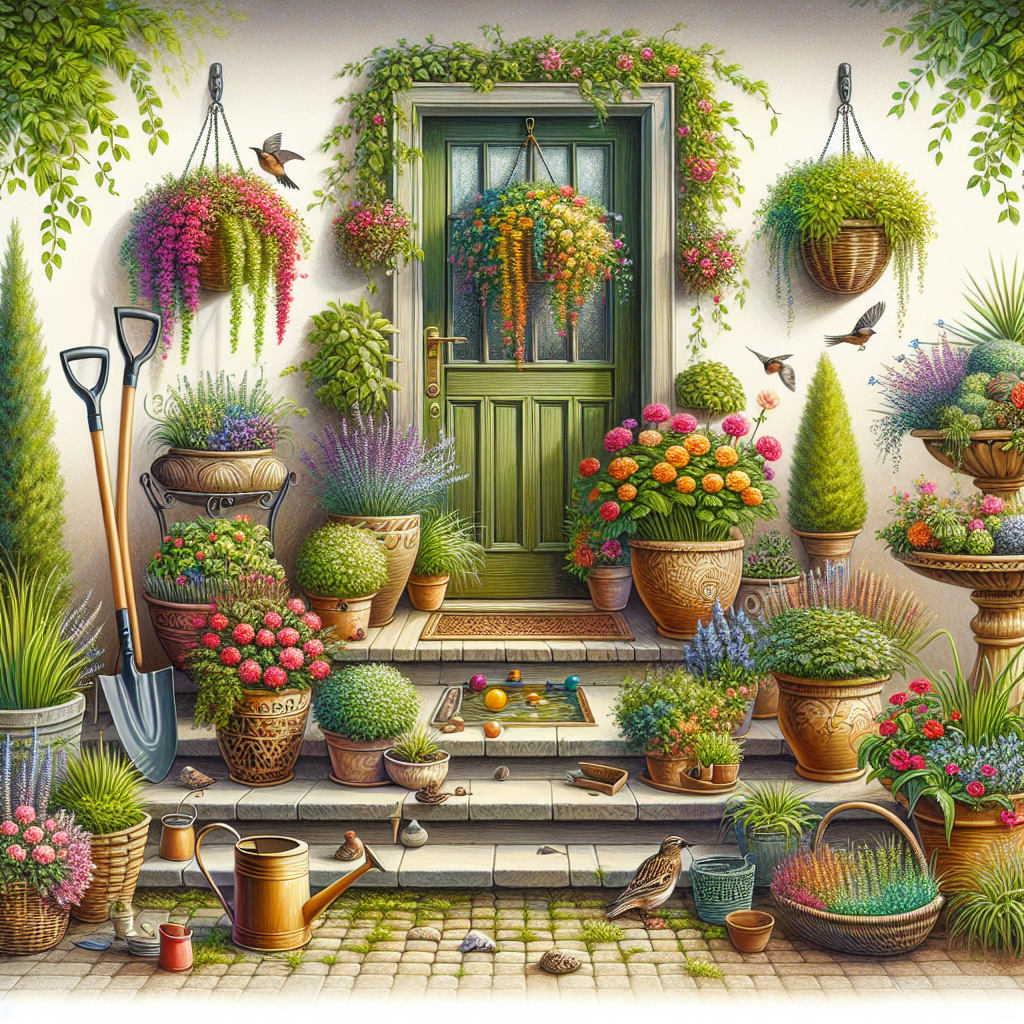
Imagine walking up to your front door and being greeted by a vibrant and lush container garden that instantly brightens your day. With a few simple tips and tricks, you can easily transform your entryway into a stunning oasis filled with beautiful flowers and lush greenery. Whether you have a spacious patio or a small balcony, a container garden can add a pop of color and charm to any space. So, get ready to roll up your sleeves and let’s dive into the wonderful world of creating a stunning entryway with a container garden!
Choosing the Right Containers
Determine the available space
When creating a container garden for your entryway, it’s important to consider the available space. Whether you have a small porch or a grand entrance, knowing how much room you have will guide your container choices. Measure the dimensions of your entryway and take note of any obstacles such as doorways or windows. This will help you determine the size and number of containers that will fit comfortably in the space.
Consider the overall style
The containers you choose should complement the overall style of your entryway and home. If you have a modern architectural design, sleek and minimalistic containers would be a great fit. On the other hand, if your entryway exudes a more rustic or traditional vibe, consider using containers made from natural materials such as clay or wood. The goal is to create a cohesive and visually appealing look that enhances the aesthetic of your entryway.
Select appropriate container materials
When selecting containers for your entryway garden, it’s crucial to choose materials that are suitable for outdoor use and can withstand various weather conditions. Materials such as ceramic, fiberglass, or metal are durable and can withstand exposure to the elements. Additionally, consider the weight of the containers, especially if you plan on moving them around. Lightweight materials like plastic or resin can be easier to handle while still offering durability.
Think about the maintenance involved
Different materials and styles of containers require varying levels of maintenance. For example, clay pots are porous and may require more frequent watering, while plastic pots retain moisture better. Consider your lifestyle and how much time and effort you are willing to dedicate to maintaining your container garden. This will help you choose containers that align with your maintenance capabilities and ensure the longevity of your plants.
Selecting the Perfect Plants
Assess the lighting conditions
Before choosing plants for your entryway container garden, it’s crucial to assess the lighting conditions. Is your entryway in full sun, partial shade, or full shade? Certain plants thrive in specific light conditions, so it’s important to choose ones that are suitable for your entryway’s lighting. If you have a sunny entryway, consider vibrant flowers like petunias or marigolds. For shady areas, opt for plants like ferns or hostas that thrive in low light.
Consider the climate
The climate in your area plays a significant role in determining the success of your container garden. If you live in a region with harsh winters, it’s important to choose plants that can withstand the cold or can be easily moved indoors. On the other hand, if you reside in a hot and dry climate, select drought-tolerant plants that can survive with minimal watering. Understanding your climate will help you choose plants that are more likely to thrive and provide year-round appeal.
Choose plants with different textures and heights
To create visual interest and dimension in your container garden, select plants with a variety of textures and heights. Combining plants with different leaf shapes, such as spiky grasses or broad-leafed ferns, will add visual depth. Additionally, incorporating plants of varying heights, like tall ornamental grasses alongside shorter flowers, can create a dynamic and dynamic display. Mix and match different plant varieties to create a unique and captivating entryway garden.
Explore various colors and bloom times
A container garden is an opportunity to infuse color and beauty into your entryway. Consider plants with different bloom times to ensure a continuous display of flowers throughout the seasons. Opt for a mix of annuals and perennials to achieve this. Explore a color palette that complements your home’s exterior, whether it’s vibrant and bold or soft and pastel. Don’t be afraid to experiment with different combinations to create a stunning visual impact.

Designing the Layout
Create a focal point
When designing your entryway container garden, it’s essential to create a focal point that draws attention and adds visual interest. This could be a central container with a striking plant or a group of containers arranged in a visually appealing way. Consider using a taller plant or a unique sculpture as the focal point to anchor the design. By creating a focal point, you make a statement and set the tone for the rest of your entryway garden.
Balance asymmetry
A well-balanced entryway container garden is pleasing to the eye and creates a sense of symmetry. However, playing with asymmetry can also be visually appealing and add character to your design. Experiment with different container sizes, shapes, and plant heights to create an interesting juxtaposition. For example, if you have a large container on one side, balance it with a cluster of smaller containers on the other side. Achieving the right balance between symmetry and asymmetry will result in a visually pleasing entryway garden.
Consider the entryway architecture
The architecture of your home’s entryway can provide inspiration for the design of your container garden. Take note of the lines, shapes, and colors of the entryway and incorporate those elements into your garden design. For example, if your entryway features arched doorways, consider using containers with rounded shapes or cascading plants that mimic the curves. By harmonizing your container garden with the architecture, you create a cohesive and integrated look.
Play with different pot arrangements
Container garden design is all about creativity and experimentation. Don’t be afraid to play with different pot arrangements to achieve the desired look for your entryway. Try grouping containers of varying sizes together for a visually impactful display. Alternatively, arrange containers in a linear fashion to create a sense of symmetry. You can also elevate some containers using pedestals or plant stands to add height and visual interest. The possibilities are endless, so have fun and let your creativity shine.
Preparing the Containers
Ensure adequate drainage
One of the most important aspects of container gardening is ensuring adequate drainage. Without proper drainage, excess water can pool in the containers, leading to root rot and other plant diseases. To promote drainage, ensure that your containers have drainage holes at the bottom. You can also place a layer of gravel or broken pottery shards at the bottom of the containers to create a space for excess water to escape. Adequate drainage will help keep your plants healthy and thriving.
Select the right potting mix
Choosing the right potting mix is crucial for the success of your container garden. Opt for a high-quality potting mix that is specifically formulated for container gardening. These mixes are lightweight, well-draining, and provide the necessary nutrients for your plants. Avoid using regular garden soil, as it can become compacted in containers and hinder root growth. A good potting mix will provide a healthy environment for your plants to grow and thrive.
Consider adding slow-release fertilizers
To ensure that your plants receive a steady supply of nutrients throughout the growing season, consider adding slow-release fertilizers to your container garden. These fertilizers release nutrients gradually, providing a consistent source of food for your plants. Follow the manufacturer’s instructions for application rates and timings. Slow-release fertilizers can help prevent nutrient deficiencies and promote healthy growth in your entryway garden.
Pre-soak plants if needed
If you are planting container-grown plants, it’s essential to pre-soak them before planting. This helps to hydrate the plants and loosen the root ball, making it easier for them to establish in their new containers. Fill a bucket or a tub with water and carefully place the plant in, making sure that the root ball is completely submerged. Allow the plant to soak for a few minutes, ensuring that the soil is thoroughly moistened. After pre-soaking, gently remove the plant from the water and plant it in the prepared container with the potting mix.

Arranging the Containers
Optimize space with vertical gardening
If you have limited space in your entryway, consider utilizing vertical gardening techniques to make the most of the available room. Vertical gardening involves growing plants vertically on walls or trellises, allowing you to maximize the vertical space. Install wall-mounted planters or attach trellises to your containers to create a vertical garden display. This not only adds greenery to your entryway but also creates a visually stunning focal point.
Place taller plants at the back
When arranging your containers, it’s important to consider the height of the plants. Place taller plants at the back of the display to create depth and prevent smaller plants from being overshadowed. This ensures that each plant has an opportunity to be seen and appreciated. Consider using containers of varying heights or elevating some containers with pedestals to achieve the desired height arrangement. By strategically placing the taller plants, you create a visually appealing and well-balanced container garden.
Experiment with grouping and layering
Grouping and layering containers can add visual interest and create a lush and abundant look to your entryway garden. Try grouping containers of similar styles or colors together to create a cohesive display. You can also create layers by placing shorter containers in front of taller ones, creating a cascading effect. Experiment with different combinations and arrangements to find the one that appeals to you the most. The key is to create a visually appealing and well-coordinated container garden.
Consider using pedestals or plant stands
Adding pedestals or plant stands to your entryway container garden can elevate the overall look and create variation in height. Place taller containers on pedestals or use plant stands to create levels within your display. This not only adds visual interest but also provides a backdrop for showcasing your plants. Additionally, pedestals and plant stands make it easier to care for your plants as they elevate them to a more accessible height. Consider using different materials and shapes to complement your overall container garden design.
Adding Decorative Elements
Incorporate trellises or arbors
To add a touch of elegance and vertical interest to your entryway container garden, incorporate trellises or arbors. These structures provide support for climbing plants and create a stunning backdrop for your containers. Choose trellises or arbors that complement the style of your entryway and containers. Whether you opt for a classic metal trellis or a wooden arbor, these decorative elements bring a sense of charm and sophistication to your container garden.
Introduce ornamental sculptures or lanterns
For a truly unique and personalized touch, consider incorporating ornamental sculptures or lanterns into your entryway container garden. These decorative elements add a sense of artistry and create a focal point within your garden. Choose sculptures or lanterns that reflect your personal style and complement the overall aesthetic of your entryway. Whether it’s a whimsical animal sculpture or a sleek lantern, these additions will add a touch of personality and create a conversation piece.
Include natural elements like rocks or pebbles
To create a more organic and natural feel in your entryway container garden, consider including natural elements like rocks or pebbles. Place them strategically around the base of your containers or use them as a border for your garden. Not only do these elements add texture and visual interest, but they also help to retain moisture and improve drainage. Natural elements blend seamlessly with the plants and containers, enhancing the overall aesthetic of your entryway garden.
Incorporate seating or benches
Transform your entryway into a tranquil retreat by incorporating seating or benches into your container garden. This allows you and your guests to enjoy the beauty of your garden up close and adds a welcoming touch to your entryway. Choose seating options that are both comfortable and weather-resistant. Consider benches with built-in storage for added functionality. By including seating, you create a space for relaxation and make your entryway more inviting.

Considering Maintenance
Establish a watering schedule
Proper watering is essential for the health and vitality of your entryway container garden. Establish a watering schedule that takes into account the specific needs of each plant and the prevailing weather conditions. Factors such as the type of plants, container size, and climate all influence the frequency and amount of watering required. Monitor the moisture levels of the soil regularly and adjust your watering schedule accordingly. Adequate and consistent watering will ensure that your plants thrive and flourish.
Monitor soil moisture levels
In addition to establishing a watering schedule, it’s important to actively monitor the moisture levels of the soil in your containers. Stick your finger into the soil to a depth of about an inch. If it feels dry, it’s time to water. If it feels moist, hold off on watering for a few more days. Overwatering can lead to root rot, while underwatering can cause the plants to wither. Regularly checking the soil moisture levels will help you maintain the proper balance and ensure the health of your plants.
Prune and deadhead regularly
To keep your entryway container garden looking its best, regular pruning and deadheading are necessary. Pruning involves cutting back overgrown or damaged branches, while deadheading refers to removing spent flowers. By pruning, you maintain the shape and size of your plants, promoting healthy growth. Deadheading encourages continued blooming and prevents the plants from diverting energy into seed production. Regularly inspect your plants and remove any dead or damaged growth to keep your entryway garden thriving.
Protect plants from extreme weather
Extreme weather conditions can take a toll on your entryway container garden. It’s important to protect your plants from harsh winds, frost, or excessive heat. Consider placing windbreaks around your garden to shield the plants from strong winds. During winter months, move frost-sensitive plants indoors or provide them with protective coverings. Similarly, provide shade or use sun-protective screens during scorching summer days. Taking precautions to protect your plants from extreme weather will help preserve their health and ensure year-round appeal.
Adding Supplementary Features
Install lighting for evening appeal
To extend the beauty and enjoyment of your entryway container garden into the evening hours, consider installing lighting features. Outdoor lighting not only highlights your plants but also creates a warm and inviting ambiance. Place solar-powered path lights or LED spotlights strategically around your garden to illuminate key plants and architectural features. This allows you and your guests to appreciate the beauty of your container garden even after the sun sets.
Include an automatic watering system
If you have a busy lifestyle or find it challenging to consistently water your container garden, consider installing an automatic watering system. These systems can be set on timers and deliver water directly to the containers, ensuring that your plants receive the proper amount of moisture. There are various options available, from simple drip irrigation systems to more advanced programmable systems. Choose one that suits your needs and offers convenience in maintaining your entryway garden.
Consider installing an irrigation drip system
In addition to an automatic watering system, consider installing an irrigation drip system for your entryway container garden. This type of system delivers water directly to the roots of your plants, minimizing water loss due to evaporation or runoff. Drip irrigation systems are efficient, reduce water wastage, and ensure that each container receives the right amount of water. This is especially beneficial during dry or hot periods when regular hand watering may not be sufficient.
Add a water feature like a small fountain
To create a sense of tranquility and add a touch of elegance to your entryway container garden, consider incorporating a water feature such as a small fountain. The sound of running water can create a soothing atmosphere and mask any unwanted noises from the surrounding environment. Choose a fountain that suits the scale and style of your garden, whether it’s a classical design or a contemporary sculpture. A water feature not only adds visual interest but also attracts birds and wildlife, further enhancing the ambiance of your entryway.

Common Mistakes to Avoid
Overcrowding with too many plants
One common mistake in container gardening is overcrowding the containers with too many plants. While it’s tempting to create a lush and abundant display, overcrowding can hinder the growth and health of your plants. Overcrowded plants may compete for resources like water and nutrients, leading to stunted growth and increased susceptibility to disease. To avoid this, choose plants that have similar water and light requirements, and give them enough space to grow and thrive.
Neglecting to consider plant growth
Another mistake is neglecting to consider the growth of your chosen plants. Some plants, especially perennials, can become quite large over time. Failing to factor in their mature size may result in a container garden that looks disproportionate or overcrowded. Before planting, research the growth characteristics of your chosen plants and plan accordingly. Consider whether they will outgrow the containers or need to be divided and replanted in the future.
Using mismatched containers or plants
Mismatched containers and plants can create a jarring and disorganized look in your entryway container garden. Aim for a cohesive and harmonious design by selecting containers that complement each other in terms of style, color, and material. Similarly, choose plants that have a similar aesthetic and thrive in similar growing conditions. Establishing a sense of unity in your container garden will create a visually appealing and polished look for your entryway.
Not providing adequate drainage
One of the most crucial aspects of container gardening is providing adequate drainage for your plants. Without proper drainage, excess water can accumulate in the containers, leading to root rot and other plant diseases. Ensure that your containers have drainage holes at the bottom to allow the water to escape. Additionally, use well-draining potting mix and avoid overwatering. By ensuring adequate drainage, you create a healthy environment for your plants to thrive in.
Maintaining Year-Round Appeal
Select evergreen plants for year-round foliage
To ensure that your entryway container garden maintains its beauty throughout the year, consider incorporating evergreen plants. Evergreens retain their foliage year-round, providing a constant source of greenery and visual appeal. Choose varieties that are suitable for your climate and light conditions. Whether it’s a boxwood shrub or a dwarf conifer, evergreen plants add structure and stability to your container garden, even during the winter months.
Choose plants with different bloom times
For a continuous display of flowers and color in your entryway container garden, select plants with different bloom times. Incorporate species that bloom in different seasons to ensure year-round interest and beauty. For example, plant spring-flowering bulbs like tulips, followed by summer-blooming annuals like geraniums or impatiens. As they start to fade, transition to fall-blooming perennials like asters or mums. By choosing a variety of plants with different bloom times, you ensure that there is always something eye-catching in your entryway garden.
Swap out plants seasonally
To keep your entryway container garden fresh and vibrant, consider swapping out plants seasonally. As the seasons change, switch out the plants that have finished blooming or are no longer thriving. For example, replace spring-blooming bulbs with summer-flowering annuals, and then transition to fall-blooming perennials. This allows you to keep up with the changing seasons and maintain a visually appealing display throughout the year. Regularly refreshing your container garden breathes new life into the space and keeps it looking its best.
Incorporate seasonal decorations
To add a festive and whimsical touch to your entryway container garden, incorporate seasonal decorations. During the holidays, consider adding strings of twinkling lights or festive ornaments to your containers. For the fall season, incorporate pumpkins or gourds into your garden display. Depending on the theme or occasion, you can easily switch out these decorations and create a unique and inviting entryway. Seasonal decorations not only add charm but also create a sense of celebration and anticipation.






